Tom Jr
-
- The Crowley Way Maritime Logistics Professional, Q1 2014 #32
Walk in the front door at Crowley Maritime Corporation HQ in Jacksonville, Fla., and you learn nearly everything you need to know about the company. With your visitor’s badge, you are handed a “Safety and Evacuation” brochure, and the person you are there to meet – in our case Tom Crowley, Jr. – walks down to greet you personally. Safety and People; The Crowley Way. The rest is just details.
Crowley Maritime was founded in 1892 by Thomas Crowley in San Francisco. Its fleet: A single Whitehall rowboat purchased for $80, used to ferry people and supplies from shore to ships anchored in the Bay. From these humble beginnings has grown one of the strongest and recognizable maritime franchises in U.S. history. A diverse, privately held $2B plus per year U.S.-based transport and logistics organization with a fleet of more than 200 U.S.-flagged vessels, a company which is still held privately by the Crowley family, run today and for the past 20 years by Thomas B. Crowley, Jr., Chairman and CEO.
The Best Laid Plans
From an early age Tom Crowley, Jr. knew that the family business that bore his name would indeed be his destiny, too. “I don’t know when it was exactly that I knew I wanted to work here, but with our last name attached to it, I felt that I would have something to do with the business,” said Crowley. During his high school and college years, Crowley would work at the company in a variety of jobs.
A self-described “operations guy,” he saw the diversity of the business and the operations, and saw ample opportunity for himself. Soon after joining the company upon graduating college, though, fate entered the picture, as Tom’s father became ill, and the line of succession – which he had envisioned would take 10 to 15 years – was compressed to three years when his father passed away and Tom took the helm of the $1B per year company.
At the age of 26.
“I didn’t have a lot of time to plan and think ahead of what was going to happen,” Crowley said. “And there were many days when I sat there and thought ‘is this even possible.’ But I knew that if I didn’t at least give it a try that 20 years later I would feel bad.
So I was running the company and my dad was dying at the same time, and the pressures were huge. My day-to-day strategy was ‘one day at a time.’ If I can get through this day, there will be a fresh day tomorrow,” Crowley said. “Early in my career, it wasn’t about ‘where am I going to take this company,’ or ‘what type of leader do I want to be,’ it was more about putting out fires and just trying to keep my head about me.”
And keep his head about him he did. At the time of Crowley, Jr. taking the helm, the company was a $1B per year company with about 5,000 employees. Today the company is just about 5,300 employees, but it has doubled to more than $2B per year.
Diverse Operations
Today’s Crowley Maritime is significantly changed from the time Tom Jr. took the reins, change that started with its internal structure based on Tom’s bias towards operations. Prior to him taking over, management was a traditional pyramid, with the CEO on top and all units reporting upward. Essentially Crowley turned that structure upside down and flattened the organization, streamlining the support services and building distinct business units and teams.
But the changes extended far beyond standard flow charts. As a private company, in Tom’s estimation, Crowley is opportunistic in nature. “I think all family businesses tend to be more opportunistic, and that drives diversification. You can get into things that maybe a public company would consider non-core or too outside the scope of what they do,” said Crowley. “Our family’s single holding is this company, so we needed to diversify our interest (to deal with the cyclical nature), but you have to find a balance; you can’t be too far flung. We’ve sold businesses that didn’t fit our longer term strategy, and I’m sure that will continue. But we will maintain a diversification in our operations.”
While the path to the top spot was not planned or easy, early on Tom figured his role as CEO was less about ‘managing by numbers’ and more about establishing and maintaining a consistent culture across all business lines, all locations. The goal: to extend its philosophies on people and safety across every Crowley office and employee so that no matter who or where you are, you get a similar experience in your interaction with Crowley.
“We want to build an organization of people that are able to solve problems, create solutions for our customers, and do it in such a way that we add value to the customer’s needs and their business,” said Crowley. “And we do it in a way that we treat people right, and we do things the right way. I think that carries across to all of our people and businesses that we are in.”
While ‘knowing your customers’ and ‘creating solutions’ may seem cliché, properly deployed it can lead to significant business opportunity. Take for example Crowley’s recent energy sector venture: the transport of crude oil coming from the shale oil (and gas) revolution in the U.S.
Crowley has been a steady customer for several U.S. shipyards, making significant investments in new tonnage for the Jones Act trade, including the construction of its state-of-the-art tug fleet, ATBs and double hull equipment as well as a recent historic order for a series of new ConRos with VT Halter (see related story, page 38). But it is the shale oil and gas development that has come as perhaps the biggest surprise, and is a direct result of Crowley’s close relationship to its oil major customers to know their needs in regards to transport.
“I think my dad and his management team found very unique designs of equipment, built a whole bunch and then they went and found opportunities,” Crowley said. “We’ve taken a different tack in our recent newbuilding program, with costs being a lot higher than they were in the 1970s. We have to take a hard look at new technologies and the efficiencies they offer in terms of crewing and fuel. We have to look at the deployment of more specialized assets that have specific purposes instead of a more general vessel that can do a lot of things OK. You have to better understand your customer needs to know their requirements, instead of just going out and building something. Moving more toward partnering with our customers, understanding their needs and building a piece of equipment that fits those requirements.”
The rapid development of the shale oil and gas business in the U.S. is a great example of a private company such as Crowley acting almost immediately to fill a void in the market, creating an interesting business opportunity while fulfilling a client need.
“We embarked on a newbuild program with our ATBs to replace the single hull tonnage that was being phased out, and we felt that we were an early mover into the ATB space, building out a fleet of 17 vessels,” Crowley said. “So we were pretty in tune with what our customer base needed in terms of transportation, across the oil majors. None of them saw this coming. We didn’t see this coming. When it happened we were in a fortunate situation where we were able to conclude a deal very quickly,” to acquire a pair of tankers, Florida and Pennsylvania, built by Aker Philadelphia.
In a matter of weeks Crowley had commandeered a deal for the tanker to enter a business – the transport of U.S. crude – that previously was completely off of the company’s radar. With the two tankers under the Crowley colors, it expanded quickly and committed to four more tankers, and Crowley said that there could be even more orders in the future.
“Clearly it was not anticipated that our equipment would be moving crude,” Crowley said. “We felt that the domestic fleet would be moving product from refinery to refinery. The other big trade for us was supplying Florida from the Gulf, but with gasoline and diesel, we never expected crude to be moving. We are moving crude from Corpus Christi to the Louisiana Offshore Oil Port (LOOP). Our tanker is so small, as I understand it, we only fill up the pipeline from the header to the shore. We don’t even get enough crude in the pipeline to get it to land, but that’s the most efficient way to move it” because there is no infrastructure yet in place.
Safety: Job One
In regards to safety, Crowley is somewhat fanatical, and given that half of its business is derived in and around the energy sector, it is understandable. Regarding the safety culture at Crowley, Tom said “You can’t just put it in a policy manual and leave it at that, you have to have people always thinking about it. We have found that by keeping it ever-present in our heads, that’s what gets safety performance moving.”
Crowley often repeats the mantra of “the right people with the right tools” in describing his company, particularly in regards to safety and efficiency. From his experience, staying diligent is a cornerstone to grooming an effective safety culture. While the marine market is notoriously cyclical, a company’s commitment to safety cannot.
“When you face tough economic times, a lot of people want to jump to cost cutting and saving,” Crowley said. “But you can’t send mixed messages to your team. You can’t demand performance then take away their tools. The perfect example is our safety performance. While it has cost us a lot, it has saved us a lot, whether in terms of accidents or things we don’t see. In the last five years we have had an 80% reduction in our Lost Time Incidents (LTIs), and I think if you looked at us five years ago, we were thought of as a really safe company. I think it goes to show if you put resources in, you will see results.”
That’s why every guest who enters a Crowley office receives a safety brochure, and why every meeting, every pre-project gathering, starts with a safety message or tip. But the Crowley message on safety extends far beyond informational speech and brochure, and its commitment to safety from the top down is perhaps best illustrated in the running of its 630 masters and mates through the MITAGS-PMI Navigation Skills Assessment Program (NSAP), a decision made in the wake of “a string of incidents that caused us great concern.”
The premise was a program – executed in three simulator centers including PMI, MITAGS and STAR Center – was to provide a uniform assessment program for captains. “There was no program that assesses our captains, so we created this environment within the simulator which is very controlled: 45 minutes at the bridge of a boat and it is a pressure cooker, presenting the captain with 22 decision points,” Crowley said. It took 22 months to run all 630 captains through the program, and there was a simple ‘pass / fail’ determination at the end. After the first run through, there was a 72% successful completion rate. Those needing additional training were provided classes targeting their skill gaps, and were then reassessed.
Less than 1% of existing Deck Officers were unable to successfully complete the process and were offered non-navigating positions. Approximately 17% of Deck Officers applying for a position were unable to successfully complete the assessment and were not offered employment.
“I think it goes to show that you need a good combination of both academic and practical training, and it takes time and money to get that,” Crowley said. “Our AB to Mate program will take high performing able body seamen and put them through a masters and mate program to make them a mate, and it costs about $100,000 per person.”
It could be argued that the maritime industry is in a watershed period, with an aging and rapidly changing employee base, a radical shift in the level and amount of new technologies on board vessels of all shape and size, onerous new regulation on emissions from ships and boats and a foundation change of the business itself, powered by vast new amounts of oil and gas coming from domestic sources. Amidst all of that change, the Crowley name today remains a cornerstone.
(As published in the 1Q 2014 edition of Maritime Professional - www.maritimeprofessional.com)
-
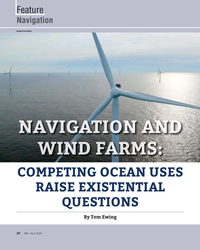 )
April 2024 - Marine News page: 20
)
April 2024 - Marine News page: 20Feature Navigation South Fork Wind COMPETING OCEAN USES RAISE EXISTENTIAL QUESTIONS By Tom Ewing 20 | MN April 2024
-
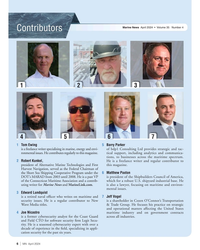 )
April 2024 - Marine News page: 6
)
April 2024 - Marine News page: 6Marine News April 2024 • Volume 35 Number 4 Contributors 1 2 3 5 4 6 7 1 Tom Ewing 5 Barry Parker is a freelance writer specializing in marine, energy and envi- of bdp1 Consulting Ltd provides strategic and tac- ronmental issues. He contributes regularly to this magazine. tical support, including
-
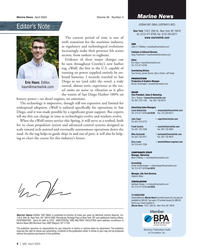 )
April 2024 - Marine News page: 4
)
April 2024 - Marine News page: 4Crowley’s new harbor Tel: 212-477-6700 tug, eWolf, the ? rst in the U.S. capable of Contributing Writers running on power supplied entirely by on- Tom Ewing, James Kearns, Barry Parker, Jeff Vogel board batteries. I recently traveled to San PRODUCTION Production & Graphics Manager Diego to
-
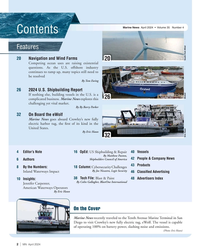 )
April 2024 - Marine News page: 2
)
April 2024 - Marine News page: 2Competing ocean uses are raising existential questions. As the U.S. offshore industry continues to ramp up, many topics still need to be resolved By Tom Ewing 26 2024 U.S. Shipbuilding Report If nothing else, building vessels in the U.S. is a 26 complicated business. Marine News explores this challenging
-
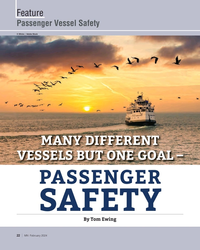 )
February 2024 - Marine News page: 22
)
February 2024 - Marine News page: 22Feature Passenger Vessel Safety © Olivier / Adobe Stock MANY DIFFERENT VESSELS BUT ONE GOAL – PASSENGER SAFETY By Tom Ewing 22 | MN February 2024
-
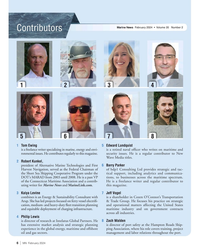 )
February 2024 - Marine News page: 6
)
February 2024 - Marine News page: 6Marine News February 2024 • Volume 35 Number 2 Contributors 3 1 24 6 5 7 8 1 Tom Ewing 5 Edward Lundquist is a freelance writer specializing in marine, energy and envi- is a retired naval of? cer who writes on maritime and ronmental issues. He contributes regularly to this magazine. security
-
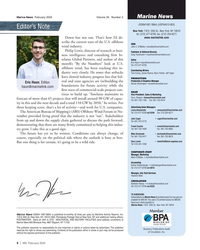 )
February 2024 - Marine News page: 4
)
February 2024 - Marine News page: 4“By the Numbers” look at U.S. Tel: 212-477-6700 offshore wind, has been tracking this in- Contributing Writers dustry very closely. He notes that setbacks Tom Ewing, James Kearns, Barry Parker, Jeff Vogel have slowed industry progress but that fed- PRODUCTION Production & Graphics Manager eral and
-
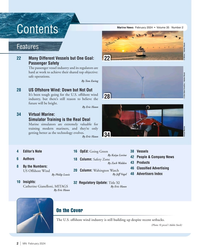 )
February 2024 - Marine News page: 2
)
February 2024 - Marine News page: 2Goal: 22 Passenger Safety The passenger vessel industry and its regulators are hard at work to achieve their shared top objective: safe operations. By Tom Ewing 28 US Offshore Wind: Down but Not Out It’s been tough going for the U.S. offshore wind 28 industry, but there’s still reason to believe the
-
 )
January 2024 - Marine Technology Reporter page: 31
)
January 2024 - Marine Technology Reporter page: 31at their mid-life point rather than module that plants itself on the bot- in Charleson, S.C. Likewise USS San incur the expense of the costly mid-life tom; the power and sensing modules; Franscisco was decommissioned in refueling. San Francisco was in com- and the business end, which is a Mark 2022
-
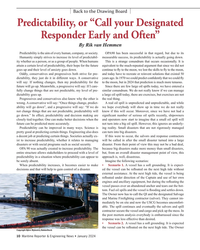 )
January 2024 - Maritime Reporter and Engineering News page: 10
)
January 2024 - Maritime Reporter and Engineering News page: 10Captain and use of her own engines and ancillary equipment, but during the re? oating the vessel passes over an abandoned anchor and tears out the bot- tom. Fuel oil spills and the vessel is ? ooding and settles down. The Owner now has to call the QI and the designated Salvage and Marine Fire? ghting
-
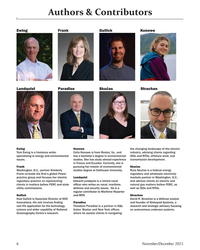 )
November 2023 - Marine Technology Reporter page: 6
)
November 2023 - Marine Technology Reporter page: 6Authors & Contributors Frank Ewing Gullick Konowe Skucas Lundquist Paradise Strachan Ewing Konowe the changing landscape of the electric Tom Ewing is a freelance writer Celia Konowe is from Reston, Va., and industry, advising clients regarding specializing in energy and environmental has a bachelor’s
-
 )
December 2023 - Maritime Reporter and Engineering News page: 24
)
December 2023 - Maritime Reporter and Engineering News page: 24speed by 10%, it would reduce underwater radiated noise by 40%, but nothing’s ever that simple. By Wendy Laursen Photo credits: © Jifmar Group Library / Tom Van Oossanen and AYRO 24 Maritime Reporter & Engineering News • December 2023 MR #12 (18-33).indd 24 12/5/2023 12:29:05 P
-
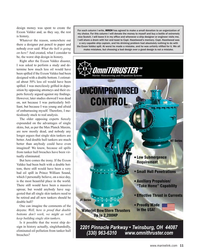 )
December 2023 - Maritime Reporter and Engineering News page: 11
)
December 2023 - Maritime Reporter and Engineering News page: 11disaster, I was asked to perform a study and de- termine how much less oil would have been spilled if the Exxon Valdez had been designed with a double bottom. I estimat- ed about 50% less oil would have been spilled. I was mercilessly grilled in depo- sition by opposing attorneys and their ex- perts ? ercely
-
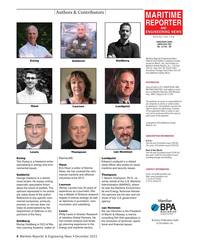 )
December 2023 - Maritime Reporter and Engineering News page: 4
)
December 2023 - Maritime Reporter and Engineering News page: 4van Hemmen One full year (9 printed issues) $140.00; two years $180.00 (18 printed issues) including postage and handling. Ewing MarineLMS. Lundquist Tom Ewing is a freelance writer Edward Lundquist is a retired specializing in energy and envi- Haun naval of? cer who writes on naval, ronmental issues
-
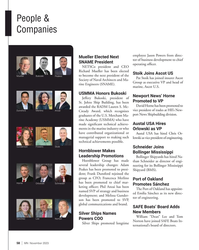 )
November 2023 - Marine News page: 58
)
November 2023 - Marine News page: 58been promoted to SVP, tor of engineering. global communications and brand. SAFE Boats’ Board Adds New Members Silver Ships Names William “Dean” Lee and Tom Sánchez Lee Norton Powers COO Silver Ships promoted longtime Norton have joined SAFE Boats In- ternational’s board of directors. 58 | MN November
-
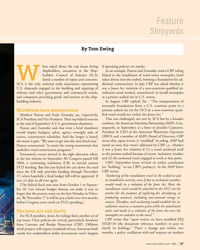 )
November 2023 - Marine News page: 37
)
November 2023 - Marine News page: 37Feature Shipyards By Tom Ewing hen asked about the top issues facing if operating policies are murky. shipbuilders, executives at the Ship- As an example, Paxton and Zorensky cited a CBP ruling builders Council of America (SCA) linked to the installation of wind tower monopiles (steel W listed a number
-
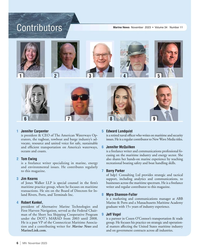 )
November 2023 - Marine News page: 6
)
November 2023 - Marine News page: 6McQuilken oceans and coasts. is a freelance writer and communications professional fo- cusing on the maritime industry and energy sector. She 2 Tom Ewing also shares her hands-on marine experience by teaching is a freelance writer specializing in marine, energy recreational boating safety and
-
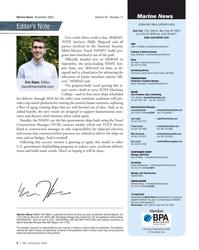 )
November 2023 - Marine News page: 4
)
November 2023 - Marine News page: 4series-leading NSMV, Em- Tel: 212-477-6700 pire State, was “delivered on time, as de- Contributing Writers signed and at a ? xed price for advancing the Tom Ewing, James Kearns, Barry Parker, Jeff Vogel education of future merchant marine of? - PRODUCTION Production & Graphics Manager cers,” MARAD
-
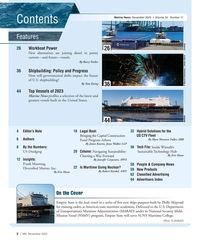 )
November 2023 - Marine News page: 2
)
November 2023 - Marine News page: 2future—vessels. By Barry Parker 36 Shipbuilding: Policy and Progress How will governmental shifts impact the future of U.S. shipbuilding? By Tom Ewing 36 44 Top Vessels of 2023 Marine News pro? les a selection of the latest and greatest vessels built in the United States. MARAD © Maxim Khalansky
-
![MR Nov-23#36 seen as an impediment “He [Tom Crowley] knows the importance](https://images.marinelink.com/images/magazines/w200h250c/MaritimeReporter-202311-page38.png) )
November 2023 - Maritime Reporter and Engineering News page: 36
)
November 2023 - Maritime Reporter and Engineering News page: 36decades, as traditional maritime of the company plus the data strategy and the digital journey.” mindset has, at times, been seen as an impediment “He [Tom Crowley] knows the importance of technology; Eto achieving next-level ef? ciency. we don't have to convince him,” said Graziuso, noting that’s Enter
-
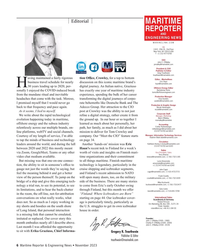 )
November 2023 - Maritime Reporter and Engineering News page: 6
)
November 2023 - Maritime Reporter and Engineering News page: 6.com President & COO Publisher & Editor Greg Trauthwein [email protected] aving maintained a fairly rigorous tion Of? ce, Crowley, for a top to bottom Editor - MarineNews Eric Haun business travel schedule for nearly discussion on this iconic maritime brand’s [email protected] H30 years leading
-
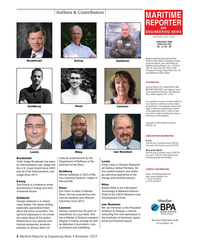 )
November 2023 - Maritime Reporter and Engineering News page: 4
)
November 2023 - Maritime Reporter and Engineering News page: 4in the Web: www.marinelink.com rine Learning Systems, maker of energy and maritime sectors. t: (212) 477-6700 f: (212) 254-6271 Ewing MarineLMS. Tom Ewing is a freelance writer Riley specializing in energy and envi- Haun Robert Riley is the Information ronmental issues. Eric Haun is editor of
-
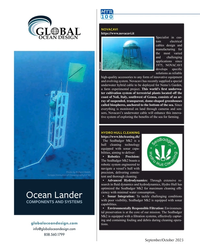 )
September 2023 - Marine Technology Reporter page: 74
)
September 2023 - Marine Technology Reporter page: 74MTR 100 NOVACAVI https://www.novacavi.it Specialist in cus- tom electrical cables design and manufacturing for the most varied and challenging applications since 1975, NOVACAVI develops speci? c Novacavi solutions as reliable high-quality accessories to any form of innovative equipment and
-
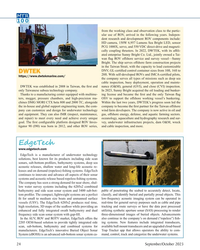 )
September 2023 - Marine Technology Reporter page: 24
)
September 2023 - Marine Technology Reporter page: 24offshore service and survey vessel—Sunny Bright. The ship serves offshore farm construction projects in the Taiwan Strait, with the capacity to load customizable DNV, GL-certi? ed control container sizes from 10ft, 16ft to DWTEK 20ft. With self-developed ROVs and IMCA-certi? ed pilots, https://www.dwtekmarin
